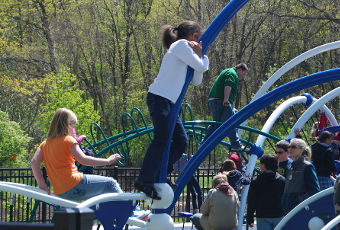
La muchacha miraba televisión mientras comía una pizza.
In Spanish there are different tenses to talk about the past, one of them is the imperfect tense. We use it to describe characteristics of an event, the time in the past, the appearance of a person or thing in the past, habits or routines in the past, contrast between the past and now and periods of time in the past. It is important to use the preterite and the imperfect accurately, as they are often confused. Read these notes about the imperfect tense and then practice with the exercise below.
La forma: ¿Cómo formar el imperfecto?
| Hablar | Comer | Vivir | |
|---|---|---|---|
| Yo | hablaba | comía | vivía |
| Tú | hablabas | comías | vivías |
| Él, Ella, Usted | hablaba | comía | vivía |
| Nosotros/as | hablábamos | comíamos | vivíamos |
| Vosotros/as | hablábais | comíais | vivíais |
| Ellos, Ellas, Ustedes | hablaban | comían | vivían |
There are only three irregular verbs in the imperfect tense.
Verbos irregulares: Solo hay tres verbos irregulares en este tiempo.
| Ir | Ser | Ver | |
|---|---|---|---|
| Yo | iba | era | veía |
| Tú | ibas | eras | veías |
| Él, Ella, Usted | iba | era | veía |
| Nosotros/as | íbamos | éramos | veíamos |
| Vosotros/as | ibais | erais | veíais |
| Ellos, Ellas, Ustedes | iban | eran | veían |

Ayer, a las 4, los niños jugaban en el parque.
Uso del imperfecto
1. Description of characteristics of an event or fact
- Descripción de características de un evento o hecho:
2. The time in the past
- La hora en el pasado:
3.Physical description of a person or animal in the past
- Descripción física de una persona o animal en el pasado:
4. Description of objects in the past
- Descripción de objetos en el pasado:
5. To describe habits in the past, routines in a life period.
- Describir acciones habituales en el pasado, rutinas en un período de la vida.
6. To express contrast between present and past states.
- Expresar contraste entre el estado actual y estados anteriores.
7. Periods of life.
- Etapas de la vida.
8. To describe moods, conditions or states of being in the past.
- Describir el ánimo, condiciones o estados del pasado.
9. When an action is interrupted by another action in the preterite.
10. To describe two actions happening at the same time in the past. We use the word “mientras” to mean “while”.
The imperfect progressive, used in combination with the preterite, describes a past action in progress that is interrupted by another action. We use the preterite for the action that interrupts and the imperfect progressive for the action in progress. We form this tense with the verb “estar” in the imperfect and the gerund of the action we want to mention.
You may also wish to review the Spanish preterite.
After reading these notes on the Imperfect tense and reviewing the preterite, complete the following exercise with the correct tense and form.
Completa los espacios con la forma correcta de los verbos en el pretérito o imperfecto
Note: Try to use the correct written accents if you can e.g.: á, é, í, ó, ú, ñ, ü.
If you don't know the correct answer, type '?' to reveal it.
Hace dos años nosotros (ir)
 a visitar a unos amigos que (vivir)
a visitar a unos amigos que (vivir)
 en la playa del golfo de México. Ellos nos (llevar)
en la playa del golfo de México. Ellos nos (llevar)
 a ver uno de los museos del lugar. Allí, nosotros (ver)
a ver uno de los museos del lugar. Allí, nosotros (ver)
 artefactos antiguos. Dicen que esos objetos los (fabricar)
artefactos antiguos. Dicen que esos objetos los (fabricar)
 los indígenas del lugar. Cuando los indígenas (vivir)
los indígenas del lugar. Cuando los indígenas (vivir)
 allí,(cultivar)
allí,(cultivar)
 muchas ortralizas y frutas. Ellos las (vender)
muchas ortralizas y frutas. Ellos las (vender)
 en el mercado los domingos. A los indígenas (gustarles)
en el mercado los domingos. A los indígenas (gustarles)
 fabricar objetos con formas de animales.Varios de esos objetos (estar)
fabricar objetos con formas de animales.Varios de esos objetos (estar)
 en exposición en el museo.Ese fue un viaje maravilloso, nosotros (aprender)
en exposición en el museo.Ese fue un viaje maravilloso, nosotros (aprender)
 mucho de todo en las dos semanas que estuvimos allí.Cuando nosotros (regresar)
mucho de todo en las dos semanas que estuvimos allí.Cuando nosotros (regresar)
 a Charleston (revelar)
a Charleston (revelar)
 muchas fotos del viaje.Lo (pasar)
muchas fotos del viaje.Lo (pasar)
 maravillosamente.
maravillosamente.
Click below to register for a free class with no obligation - no credit card needed.